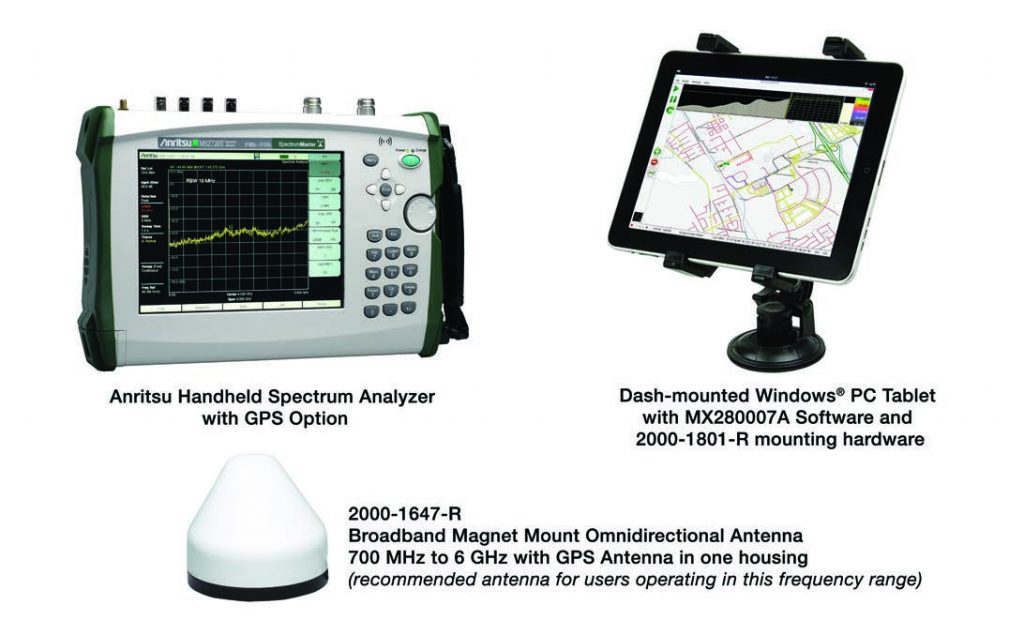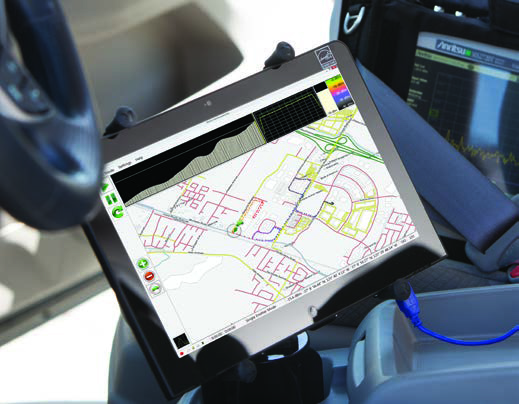
Interference from both illegal and unintentional signals is a significant problem for mobile service providers, security services and government regulators. Interference can often degrade network performance, causing critical communications to be interrupted. Locating these sources of interference has traditionally been labor intensive and time consuming. Traditional methods include manually making numerous measurements from multiple locations using a directional antenna. Triangulation is then used to approximate the signal location. This process is then iterated a number of times until the interferer is precisely located.
The Anritsu mobile interference hunting system automates the interference hunting process. Multiple measurements are automatically taken and processed using the MX280007A InterferenceHunter™ software. Using this interference localization software resident on a Windows® laptop/tablet, figure 1, an Anritsu handheld spectrum analyzer and an omnidirectional antenna, directions and voice prompts are provided in this system to guide the driver to the source of interference.
This application note will focus on the operation of the mobile interference hunting system. Settings for both the MX280007A software and for the spectrum analyzer will be outlined, consistent with both the type of interference to be hunted and the terrain in which the interference hunt is to take place, see figure 2. Various use case scenarios will also be examined to illustrate how the system is optimized for finding various types of interference.

The patent-pending algorithm in the Anritsu Mobile InterferenceHunter software uses power-of-arrival technology to quickly measure and locate sources of interference. To guide the user to the interferer position, directional arrows are positioned on the map. The accuracy of these directions is enhanced with GPS technology to precisely identify the driver’s position and the path to follow. Additionally, voice prompts are given allowing the user to minimize the need for viewing the map while driving. This helps to facilitate one-person operation. Voice prompts can be played on the tablet itself or fed into the car speaker system with an audio cable. Bluetooth® wireless technology can also be used where both the vehicle radio and the tablet are equipped with this feature. Care must be taken to insure that Bluetooth transmissions are not in the same frequency band being searched for interference.
The interference hunting algorithms employ channel power measurements. This feature facilitates hunting a wide variety of signal types, from wideband modulated signals to narrowband or CW sources. The channel power bandwidth can be easily configured by the user for settings appropriate for the signal of interest.
Once sufficient measurements are accumulated and filtered for multipath, the Anritsu Mobile InterferenceHunter software draws a circle on the map indicating the position estimate of the source of interference. The diameter of the circle becomes smaller as more measurements are taken, providing a higher degree of confidence for the signal of interest. While driving, a series of color-coded dots is shown on the map, with color proportional to signal strength.
On set-up of the mobile interference hunting system, a USB cable is attached between the spectrum analyzer and the Windows tablet. On boot-up, the spectrum analyzer is automatically placed into channel power mode. The operator sets the frequency, channel bandwidth and a few other settings. The appropriate OpenStreetMap™ is loaded into the program by the user. Alternatively, Google Maps™ can be utilized by the user (requires internet access for the duration of the interference hunt).
Once the user gets close enough to the interferer location, the Anritsu handheld spectrum analyzer with a Yagi or other directional antenna can then be used to pin-point the interferer. It is highly recommended that the Anritsu MA2700A Handheld InterferenceHunter device be used as part of this pin-pointing operation.
In developing the Anritsu Mobile InterferenceHunter software, great care was taken to insure user-friendliness and simplicity of use. With an interface optimized for Windows touchscreen tablets, the Mobile InterferenceHunter software is simple to use.
Types of Interferers Found
- Low power
- Narrowband, wideband
- Modulated
- Pulsed signals (similar to radar)
- Signals hidden in LTE uplink channels
- “Black” TV/radio stations and BTS cellular equipment operating illegally
Post Interference Hunt Analysis
Records of your interference hunt can be saved as log files either for submission to management or for use in analyzing the hunt itself. The log files can be re-played on the MX280007A software to examine the drive route taken and to review areas where the hunting process might be optimized.
Request More Information
"*" indicates required fields


